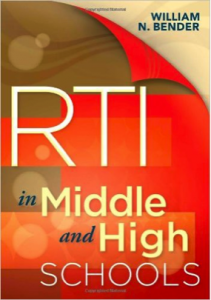A Resource to Support RTI in Secondary Schools
RTI in Middle and High Schools
By William N. Bender
(Solution Tree, 2012 – Learn more)

RTI in Middle and High Schools by William N. Bender makes a case for the need to implement Response to Intervention (RTI) in secondary schools. The book aims to give teachers, administrators and school-based PLCs guidelines on how to effectively use RTI in conjunction with differentiated instruction and technology strategies to enhance students’ learning in all subject areas.
Bender provides plans and real-life case studies of schools that have successfully implemented the RTI model to improve students’ learning and achievement. Although he admits that much of RTI research is on implementation in the elementary school, Bender maintains RTI can be a very useful learning tool in both middle and high schools, particularly when combined with technology and differentiated instruction.

► The book is divided into eight chapters, each highlighting different instructional strategies, curricula, and progress-monitoring programs, and discussing the major responsibilities within RTI and the core subject areas.
► It provides real-world examples of RTI implementation in middle and high schools, RTI documentation forms in various content areas, guidelines and lists of instructional procedures, and suggestions for lesson plans and further resources.
► While the impact of RTI alone will be significant, Bender believes that when it is coupled with differentiated lesson activities and supported by up-to-date instructional technologies, the impact is likely to refocus instruction in middle and high school classes rather drastically.
Some reflections inspired by the book
As a teacher with experience across the K-12 spectrum, I agree with the author’s claim that the combined impact of differentiated instruction, RTI, and modern technology for teaching will result in middle and high school classrooms that look and function differently from traditional settings.
Students in middle and high schools are familiar with many of the technologies available today. They may not use it for learning, but it can be redirected to become a vital learning tool for this generation of students. I think newly graduated teachers may be as versed in these modern technology tools as most students; therefore why not maximize its use to enhance students’ learning?
One may wonder, what about veteran teachers, or those of us who were raised and educated in the “dinosaur age” (like my kids would say). I think we can learn a thing or two from the students themselves. Learning is never one-sided, and for all teachers to “catch up,” regular up-to-date trainings aimed at ensuring teachers are aware of new programs and how to use them effectively can make a big difference.
RTI implementation is in the second year in my school district. I have not been involved in its implementation (I’m currently in graduate school), but this book is certain to be helpful, with its guidelines and strategies (even ideas for teaching writing as one would teach reading, without assuming students come to secondary school with all the knowledge and skills they need).
We are in the 21st century, a new era of modern technology in every direction. It is time to prepare students for a future that requires some technology skills for sheer survival. To continue traditional ways of teaching will only help to ensure students’ continued failure, dropouts or inadequately prepared students who may not be able to contribute meaningfully to the society.
I would recommend this book to my colleagues, teachers, school administrators, and every professional learning community (e. g., in elementary, middle and high schools) involved in implementing RTI. Although not much research on RTI implementation is available in the upper grades, the book presents valuable descriptions and samples of RTI implementations in schools to guide the start-up and planning.
The book does not claim to portray RTI as a program without challenge, but rather it explores possible solutions for the complex challenges the RTI implementation process brings.
Sarah Iriogbe-Efionayi is currently a graduate student. She was a secondary school science teacher for several years, and most recently was a kindergarten teacher for three years. She is the author of a paper, “The implications of Poverty and Inequality in the Education of African Americans” soon to be published in a book titled The Struggle for Human and Civil Rights and the African Diaspora in Historical Perspective. Sarah has also conducted trainings on child discipline in her local church.

































